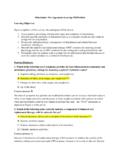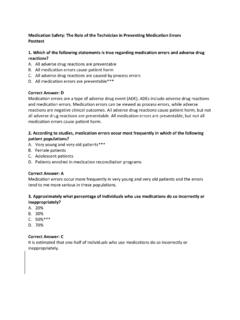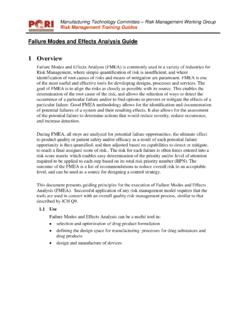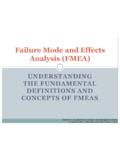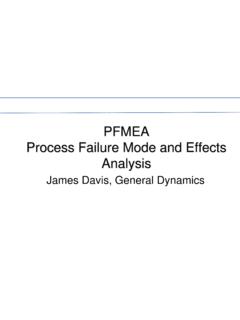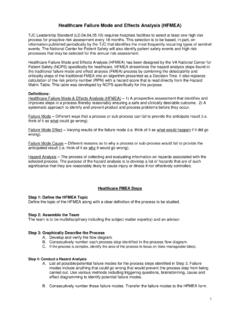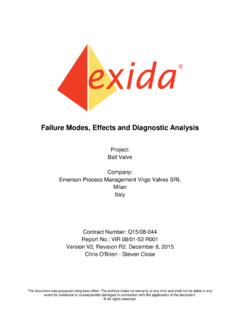Transcription of The Utility of Root Cause Analysis and Failure Mode …
1 The Utility of Root Cause Analysis and Failure Mode and Effects Analysis in the hospital Setting learning objectives : Upon completion of this activity, the participant should be able to: 1. Discuss the prevalence of medication errors in the United States;. 2. Describe the Utility of root Cause Analysis (RCA) in the health care setting;. 3. Outline the steps involved in a Failure mode and effects Analysis (FMEA);. 4. Summarize the benefits of drawing from a multidisciplinary team to complete patient safety evaluations; and 5. List 4 strategies that can be employed in the pharmacy to help reduce medication errors.
2 Post-test/Rationale 1. According to IOM estimates, how many people die each year as a result of medication errors in the United States? A. 7000**. B. 98,000. C. million D. billion Correct Answer: A. An estimated 98,000 people die every year as the result of preventable adverse events, and 7000 of these deaths are due to medication errors. 2. Which of the following statements is true regarding medication errors? A. Medication errors are usually the fault of a single individual or event B. Medication errors can occur at any stage of the medication-use process**. C.
3 Medication errors only occur while a medication is in the control of a health care professional D. All of the above Correct Answer: B. Most medication errors are not the fault of a single individual or event, but, rather, are caused by professionals operating in a highly variable and complex system of health care delivery and medication use. Medication errors can be made during any step of the medication-use process and can occur when the medication is in the control of the health care professional, patient, or consumer. It is estimated that one-third of medication errors that occur in hospitals take place in the dispensing or administration phases.
4 3. Which of the following strategies strengthens the findings and recommendations of a root Cause Analysis ? A. Implementing additional education for health care professionals after an error has occurred B. Gathering knowledge only from the individuals directly involved in a safety-related incident C. Excluding human factors from the investigation D. Supporting workplace transparency and learning across the organization**. Correct Answer: D. Weak recommendations or improvement strategies undermine the Utility of a root Cause Analysis . Education and new policies and procedures are considered weak interventions, as are repeating existing policies or confirming previous recommendations.
5 RCA teams must investigate similar errors or incidents outside the system or in literature to learn from others' experiences. Human error should be investigated to determine factors that influenced performance, such as task complexity, workflow, time availability, process design, experience, training, fatigue, and stress. Managers and administrators can encourage workplace transparency, sharing of concerns, and learning across the organization, which will support and empower all staff involved in patient care to make and sustain improvements in patient safety. 4.
6 Which of the following pairs of statements is true regarding root Cause Analysis (RCA) and Failure mode and effects Analysis (FMEA)? A. RCA is a proactive approach to risk reduction and FMEA is a reactive approach to risk reduction B. RCA identifies sources of potential Failure and FMEA identifies where processes have failed in the past C. RCA is conducted after an error occurs and FMEA can be conducted before a process is implemented**. D. RCA is a quantitative assessment of the severity, likelihood, and detectability of an error and FMEA is a qualitative assessment of latent system weaknesses Correct Answer: C.
7 An RCA asks Why did the system fail in the past?, and an FMEA asks How could the system fail in the future? An RCA is conducted after an incident has occurred and FMEA is used to identify potential sources of before an incident occurs. FMEA quantifies the severity, likelihood, and detectability of potential failures to determine where change is needed. 5. Which of the following steps is essential to the application of an FMEA? A. Assembly of an appropriate team B. Develop a process map C. Conduct a risk or hazard Analysis for each process and subprocess D. Develop an action plan and follow up on the actions taken E.
8 All of the above**. Correct Answer: E. For the best use in health care settings, an FMEA should include the following steps: Define the topic, Assemble a committed team, Develop a process map, Conduct a risk or hazard Analysis for each process and subprocess, Develop an action plan and Follow up on the actions taken. 6. Which process would be identified as most in need of change on the basis of its criticality index (CI)? A. A process with a likelihood rank of 7, a severity rank of 3, and a detectability rank of 4. B. A process with a likelihood rank of 3, a severity rank of 2, and a detectability rank of 1.
9 C. A process with a likelihood rank of 8, a severity rank of 5, and a detectability rank of 3**. D. A process with a likelihood rank of 2, a severity rank of 3, and a detectability rank of 2. Correct Answer: C. A CI is calculated by multiplying the severity rating, the probability rating, and the detectability rating. Failure modes with low CIs are unlikely to affect patient outcomes and do not require immediate attention. Failure modes with the highest CIs are prioritized for corrective action. Process A has an RPN of 84, process B, 6, process C, 120, and process D, 12.
10 7. Which of the following strategies has not been shown to reduce rates of mediation errors? A. False-positive safety alerts**. B. Barcode-assisted medication administration C. Computerized order entry D. Decision-support software Correct Answer: A. Technology plays a key role in patient safety and computerized order entry systems, decision support software, automated dispensing, and barcode-assisted medication administration have improved medication safety. Safety alerts have value in prescribing and order processing software, but many alerts are false positives or clinically irrelevant, which decreases the value of system alerts.
